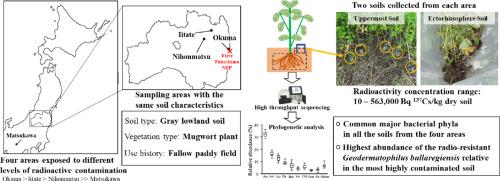Science of the Total Environment ( IF 8.2 ) Pub Date : 2020-11-21 , DOI: 10.1016/j.scitotenv.2020.143844 Hideyuki Ihara , Ayako Kumagai , Tomoyuki Hori , Kenji Nanba , Tomo Aoyagi , Mitsuru Takasaki , Yoko Katayama

|
The Great East Japan Earthquake caused a serious accident at the first Fukushima nuclear power plant (NPP), which in turn released a large amount of radionuclides. Little attention has been paid to in-situ soil microorganisms exposed to radioactive contamination by the actual NPP accident. We herein investigated bacterial communities in the radioactive cesium (Cs)-contaminated and non-contaminated soils by high-throughput sequencing. The uppermost and ectorhizosphere soil samples were collected from the base of mugwort grown in the same soil type with the same soil-use history in order to compare the bacterial communities at geographically separated areas. The concentrations of radioactive Cs in the soils ranged from 10 to 563,000 Bq 137Cs/kg dry soil, with the highest concentration being detected at 1 km from the NPP. Alpha-diversity indices, i.e., Chao1, Shannon and Simpson reciprocal, of the sequence data showed the lower bacterial diversity in the most highly Cs-contaminated soil. Principal coordinate analysis with principle components 1 and 3 based on unweighted UniFrac distances indicated the significant difference in bacterial communities of the most contaminated area from those of the other areas. Operational taxonomic unit-based assay revealed higher abundance of the radio-resistant Geodermatophilus bullaregiensis relative in the most contaminated soil. Thus, it was strongly suggested that the radioactive accident facilitated the growth and/or survival of radio-resistant bacteria in the Cs-contaminated soils. The results of this study show that information on the soil type, vegetation and soil-use history enhances the direct comparison of geographically distant soil bacterial communities exposed to different levels of radioactive contamination.
中文翻译:

从第一次福岛核电站事故中直接比较受不同水平铯污染的土壤中细菌群落的直接比较
东日本大地震在福岛第一核电站(NPP)造成了严重事故,该核电站又释放了大量的放射性核素。实际NPP事故对暴露于放射性污染的原位土壤微生物的关注很少。我们在这里通过高通量测序研究了放射性铯(Cs)污染的土壤和未污染的土壤中的细菌群落。从在相同土壤类型,相同土壤使用历史中生长的艾蒿基地收集最上层土壤和土壤根土壤样品,以比较地理上分离区域的细菌群落。土壤中的放射性Cs浓度范围为10至563,000 Bq 137Cs / kg干燥土壤,在距NPP 1 km处检测到最高浓度。序列数据的α-多样性指数,即Chao1,Shannon和Simpson倒数,显示在受Cs污染最严重的土壤中细菌多样性较低。基于未加权UniFrac距离的主要成分1和3的主坐标分析表明,受污染最严重的地区的细菌群落与其他地区的细菌群落存在显着差异。可操作的基于分类单位的分析显示出较高的抗辐射性布氏乳杆菌亲戚在污染最严重的土壤中。因此,强烈建议放射性事故促进受Cs污染的土壤中抗辐射细菌的生长和/或存活。这项研究的结果表明,有关土壤类型,植被和土壤使用历史的信息可增强对暴露于不同放射性污染水平的地理位置遥远的土壤细菌群落的直接比较。











































 京公网安备 11010802027423号
京公网安备 11010802027423号